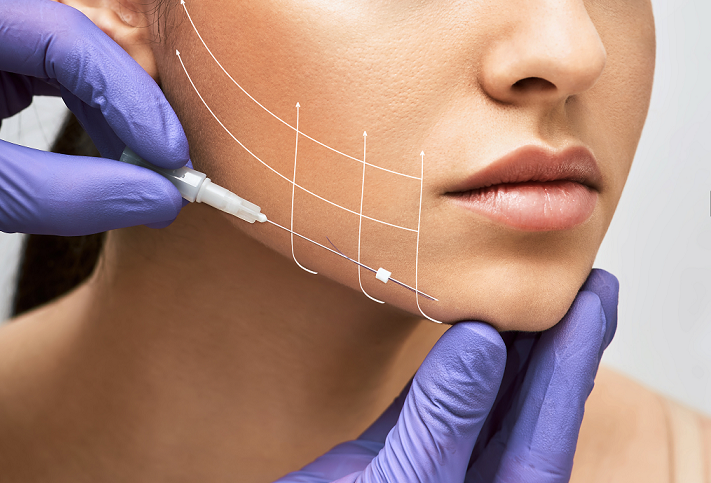Threads contouring treatment has been available for more than 100 years. This treatment failed to gain a lot of popularity due to the invasive nature and level of discomfort associated with threads treatments. Some of the threads used up to now are not biodegradable and the end result can cause visible asymmetry.
Polydioxanone (PDO) threads are not a new type of thread. Doctors have been using it for wound closure worldwide for more than 15 years. This type of thread is safe and has less discomfort and downtime associated with its less invasive insertion technique.
PDO threads are fully biodegradable and only new collagen remains after 6 months. It is non-allergenic and discomfort after insertion is moderate lasting only 3-4 days. Paracetamol 2 – 3 times a day after meals is recommended if required. Do not take any anti-inflammatory drugs (unless required for medical purposes) such as Nurofen (ibuprofen) because this category of drugs suppresses inflammation and inflammation is import for new collagen production.
Bruising associated with the threads is minimal but patients taking aspirin or other blood thinning medicine such as Plavix or vitamins such as vitamin C and vitamin E may be more prone to bruising. Some degree of swelling can be expected lasting about 2-3 days.
Existing facial asymmetry may not be completely rectified. PDO threads are not a replacement treatment for plastic surgery. Results are not guaranteed and no money refund guarantee is applicable.
Follow up review consultations are recommended after 7 days, 1 month and 3 months. However, in the event of any concerns whatsoever, please contact the practitioner responsible for your treatment immediately.
The Pre-treatment procedure:
- Taking of your medical history.
- Examination of the area to be treated
- Photography
- Prophylactic antibiotics: Oral Azithromycin 500 mg one hour before the procedure and for 2 additional days.
- Oral antihistamine to reduce swelling.
- Topical aneasthetic cream.
- Local anaesthetic injections (lignocaine) to numb the treatment areas. Your face will feel numb and your mouth may be asymmetrical for a few hours, similar to that of dental injections. Please refrain form chewing or drinking hot liquids until your face has regained full sensation.
The Treatment Procedure:
- Insertion of PDO Cog threads underneath your skin in the jawline and cheek areas: the effect is ‘lifting’ of sagging connective tissue and fat tissue underneath the skin.
- PDO monofilament threads are inserted into the skin to stimulate skin tightening.
Post-treatment Procedure:
- Application of anti-biotic cream.
- Ice packs
- Do not wash your face on the same day after the procedure. Gentle cleansing is allowed from the next day.
- Do not open the mouth wide and do not have routine dental treatment for at least 4 weeks after the treatment.
- Avoid taking aspirin for 7 days after the treatment.
- Avoid extreme temperatures (sauna, etc.) for 7 days after the treatment.
- Avoid having other cosmetic treatment for 14 days after the treatment.
When should it be not done :
1. Active acne or skin infection
2. Keloid predisposition and Auto-immune diseases: scleroderma, sarcoidosis, amyloidosis, etc.
- Anti-coagulant medication: coumarin & heparin (aspirin?)
- Haemophilia
- Pregnancy, IVF
- Malignancy/Chemotherapy
- Hepatitis B & C, HIV
- History of bacterial endocarditis: Such cleints need antibiotic prophylaxis for this procedure
- Existing systemic infection
- Porphyria
- History of Herpes simplex labialis: give oral acyclovir prophylaxis (stress)
- Dysmorphic syndrome (psychological)
- Unrealistic patient expectations
Side-effects and Complications:
- Swelling for a few days
- Bruising
- Protrusion: if the thread was placed to superficially (can be removed)
- Puncture of a blood vessel causing bruising or a haematoma. The use of cannulas to insert the deep cog threads helps to minimise this.
- Facial nerve trauma is possible if sharp needles are used to place deep cog threads. Cannulas are used to avoid this complication.
- Granuloma/foreign body reaction is the plain threads are placed too superficially in the skin. The thread can be removed.
- Existing asymmetry can’t be 100% corrected.

